The H1B visa is a nonimmigrant (temporary) visa for persons who are professionals that have at least a bachelor’s degree (or qualified equivalent experience) in a certain specialty and will be working for a U.S. employer in that specialty occupation (job position). A specialty occupation can include but is not limited to engineering, education, law, accounting, architecture, mathematics, theology, arts, medical and health, physical sciences, social sciences, and certain business specialties.
There are 2 types of H1B visas: cap-exempt H1B visas and cap-subject H1B visas. The more commonly known cap-subject H1B visa petitions starts off its registration process in the spring (H1B visa cap season is typically in March) and ends with the approved H1B visa worker starting work for the U.S. employer on October 1 of that same year. The H1B visa can be used for a part-time job or full-time job in the United States.
- 1.
- a.
- 2.
- b.
- 3.
- 4.
- a.
- b.
- 5.
- a.
- 6.
- a.
- 7.
- 8.
- a.
- b.
- 9.
- 10.
- 11.
- a.
- b.
- c.
- d.
- e.
Table of Contents
There are 2 types of H1B visas: (1) the cap-subject H1B visas and (2) the cap-exempt H1B visas.
Cap-Subject H1B Visas
A cap-subject H1B visa means that the H1B visa petition is affected by the total amount of H1B visas that can be given out that year (which usually means that the H1B visa petition may have to enter the lottery system for selection if the amount of H1B visa petitions received is more than the H1B visas that can be given out that year).
The cap-subject H1B visa has 2 main sub-categories: (1) the regular cap (for persons who have a bachelor’s degree or qualified equivalent experience) which has 65,000 visas each fiscal year and (2) the master cap (for master’s degrees or higher degrees) that 20,000 visas each fiscal year. The regular cap (65, 000 visas) additionally has to also set aside 1,400 visas for Chile nationals and 5,400 visas for Singapore nationals under the H1B1 visa.
When the amount of H1B visa petitions received is more than the quota of the H1B visas that can be given out that year, the foreign worker’s H1B visa petition will have to enter a lottery system that randomly selects which H1B visa petitions can continue to be reviewed for that year.
H1B Visa Filing Time
The process of filing a cap-subject H1B visa petition starts in March and ends when the H1B visa worker starts employment on October 1 of that same year (i.e., October 1 is the earliest date that the H1B visa worker can start working for the U.S. sponsoring employer).
The cap-subject H1B visa petitions must be electronically registered with the USCIS during March 9 to March 25 and those properly registered will go through the H1B random selection process (lottery). H1B visa registrants that are selected will be notified by March 31 and the H1B visa petition can be filed during April 1 to June 30. Additional H1B visa registrants may be selected in July or August if the cap (quota) that year is not filled.
Multiple H1B Visa Filings
The U.S. employer cannot file multiple H1B visa petitions for the same employee (even if the job positions are different or if one is filed under the regular cap and the other is filed under the advanced degree cap) to increase the chances of the person being selected in the lottery system. However, the person can have different U.S. employers file separate H1B visa petitions for them if the U.S. employers are not considered “related” and there is a legitimate business need for the H1B visa worker.
eng-1-1024x427.jpg)
A cap-exempt H1B visa means that the H1B visa petition is not affected by any limitation on the number of visas that can be granted each year (there is no set limitation on the total amount of cap-exempt H1B visas that can be given out) and it can be filed anytime throughout the year unlike cap-subject H1B visas.
Cap-exempt H1B visas are for: (1) certain types of employers, (2) persons who are already counted in the initial cap-subject H1B visas, (3) certain physicians (J1 visa medical doctors) with a Conrad waiver or federal program waiver, and (4) H1B visa workers in Guam and the Commonwealth of the Northern Marina Islands (CNMI).
H1B Visa Cap-Exempt Entity
Cap-exempt H1B visas are for employers that are:
- Institution of higher education (e.g., university, college)
- A nonprofit entity that is related or affiliated with an institution of higher education (e.g., university, college)
- Government research organization
- Nonprofit research organization (e.g., Bill and Melinda gates foundation)
Institution of Higher Education
An institution of higher education (post-secondary school) that qualifies as an H1B visa cap-exempt employer must (1) be accredited (or granted a qualified preaccreditation status), (2) is a public or nonprofit entity, (3) provide an educational program that awards a Bachelor’s degree or at least a 2-year program that is acceptable for full credit toward such as degree, (4) legally authorized under state law to provide post-secondary education and admits students that have completed secondary education (i.e., high school graduates or its equivalent).
For-profit schools cannot qualify as an H1B visa cap-exempt employer and are only allowed to file cap-subject H1B visas (e.g., that may need to go through the lottery system because too many H1B visa petitions were filed that year).
Nonprofit Entity Related or Affiliated with Institution of Higher Education
An H1B visa cap-exempt nonprofit entity should be an IRS approved research or educational tax-exempt organization under section 501(c)(3), (4), or (6) of the Internal Revenue Code.
The nonprofit entity related or affiliated with an institution of higher education (“school”) under the cap-exempt H1B visa must also satisfy at least 1 of the 4 scenarios:
- (1)
- The nonprofit is associated or connected with the school through common ownership or is controlled by the same board or federation
- (2)
- The nonprofit is operated by the school
- (3)
- The nonprofit is attached to the school as a member, cooperative, branch, or subsidiary
- (4)
- The nonprofit has a formal written affiliation agreement with the school that creates an active working relationship for educational or research purposes and the nonprofit’s fundamental activity is focused on directly contributing to the school’s research or educational mission
For example, a Veterans Affairs hospital (nonprofit entity) can be qualified as being affiliated with a medical school (instruction of higher education) if there is a contract or agreement that allows the medical school to train or educate medical personnel in the nonprofit hospital.
Governmental Research Organizations
Governmental research organizations as an H1B visa cap-exempt employer are federal, state, or local entities with primary missions to promote basic and/or applied research.
Working “at” (but not Employed by) a H1B Visa Cap-Exempt Entity
Certain H1B visa workers who will be spending most of their time working “at” a qualifying H1B visa cap-exempt entity but are not directly employed by that entity (which means the H1B visa worker is employed by another employer that is not cap-exempt under the H1B visa) may still be able to file under a cap-exempt H1B visa if their work (job duties) predominately and directly further the essential purpose, objective, functions, or missions of the qualifying H1B visa cap-exempt entity. For example, physicians employed by a private hospital but work at an H1B visa cap-exempt non-profit hospital that is affiliated with a medical school.
Already Counted for in Cap-Subject H1B Visas
After the person has been selected and approved for the initial cap-subject H1B visa, the H1B visa worker would no longer need to go through the lottery system again through their 6-year visa duration in most cases. For example, H1B visa workers filing for H1B visa extensions (renewals) with the same company or filing to change to another H1B cap-subject employer would not need to go through the lottery selection again.
Conrad Waiver
Medical doctors on a J1 visa status that is subject to the 2-year home residence requirement upon the end of their J1 exchange visitor program can obtain a Conrad waiver (or a federal program waiver) to waive that 2-year home residence requirement by working full-time in a health care facility located in an HHS designated health professional shortage area (or a medically underserved population/ medically underserved area) for at least 3 years on a cap-exempt H1B visa status.

A qualified person under the H1B visa petition must be a member of a profession and have (1) a job offer from a U.S. employer for a job position that is in a specialty occupation, (2) (a) at least a Bachelor’s degree (or its foreign equivalent) in a specific specialty or in a related field, or (b) have a combination of educational degrees, training, experience that is equivalent to having the required degree, and (3) state licenses if required for practice under state law. The degrees under the H1B visa must be from accredited colleges or universities.
The original statutory wording for qualified persons for H1B visas can be found in 8 CFR 214.2(h)(4).
Substitutions of Degree
H1B visa job positions are in professional occupations that require workers to have at least a bachelor’s degree. The H1B visa worker is allowed to substitute degrees required by the job position with certain combinations of formal education, training, and work experiences.
Bachelor's Degree Substitution
H1B visa workers without a bachelor’s degree are allowed to substitute the required bachelor’s degree with specialized training and/or work experience. The H1B visa worker can use 3 years of specialized training and/or work experience to make up for each year (1 year) of college-level education that they are missing.
Master's Degree Substitution
H1B visa workers without a master’s degree are allowed to substitute the required master’s degree with a bachelor’s degree and at least 5 years of experience in the specialty.
Ph.D. Degree Cannot Be Substituted
H1B visa workers without a doctorate (Ph.D.) are not allowed to substitute the required doctorate degree which means that the H1B visa worker must have a doctorate degree (or its foreign equivalent) if the H1B visa job position requires for it.
Generalized Degrees
For H1B visa workers with generalized degrees (e.g., business administration, liberal arts), the classes that the person took during their study can be used to show that they are qualified for specific job positions. For example, an H1B visa worker with a business administration degree can show that they qualify for an accounting job position with the number of relevant accounting classes they took while obtaining their degree.
Temporary Licenses
If the H1B visa worker only holds a temporary license, the H1B visa can only be approved for a period of up to 1 year or the period that the temporary license is valid (whichever is longer) unless (1) the H1B visa worker is allowed to perform their job duties without a permanent license under supervision or (2) the state law allows a person without a license to practice the occupation under supervision even if the occupation usually requires a license. For example, medical students in medical residency programs (e.g., resident physician) can qualify for the H1B visa even if they do not have a full and unrestricted U.S. medical license yet.
Healthcare Professionals
Medical doctors under the H1B visa can be divided into 2 main types: (1) teachers and scholars and (2) physicians providing direct patient care.
Qualified H1B Visa Medical Doctor
A qualified medical doctor under the H1B visa typically must (1) have passed the U.S. medical licensing examination administered by the U.S. Federation of State Medical Board (which would be passage of Steps 1, 2, and 3 of the USMLE), (2) be certified by the Educational Commission for Foreign Medical Graduate (ECFMG certification) if the medical doctor is an International Medical Graduate (IMG) who did not graduate from an accredited U.S. or Canadian medical school, (3) have competent proficiency in English language skills (which for IMG foreign medical doctors can be shown by passing the English test in the ECFMG certification), and (4) have authorization to practice medicine in the state they will be working in (e.g., medical license issued by the state or state law authorizes medical practice under supervision).
Exceptions to the ECFMG certification requirement under the H1B visa can be applied for:
- Medical research scholars if the dean of an accredited U.S. medical school certifies the process
- Medical doctors who are renowned on a national or international level
- Medical doctors who are not going to be working as a medical professional (e.g., pharmaceutical administrator)
- Graduated from an accredited U.S. medical school
Medical Nurses
In general, most registered nurses (RN) do not qualify for an H1B visa because no state in the United States requires a bachelor’s degree in a nursing license. However, advanced practice registered nurses (APRN) may be able to qualify for an H1B visa because of the advanced level of education and training required for their certification.
Possible APRNs can include but is not limited to:
- Certified nurse-midwife (CNM)
- Certified nurse practitioner (CNP)
- Certified clinical nurse specialist (CNS)
- Certified registered nurse anesthetist (CRNA)
Nurses under the H1B visa must also have a certification (or a certified statement) from the Commission on Graduates of Foreign Nursing Schools (CGFN) or an equivalent agency.
The H1B1 visa is available for persons who have Chilean or Singaporean nationality.
Additional Professions Under H1B1 Visas:
- Agricultural managers and physical therapists are additional professions available to persons from Chile.
- Disaster relief claims adjuster and management consultant are additional professions available to both Chileans and Singaporeans.
- Management consultants that hold a degree in a field that is not the same as their specialty occupation under the H1B1 visa can provide alternative documents that show experience in the required specialty field instead.
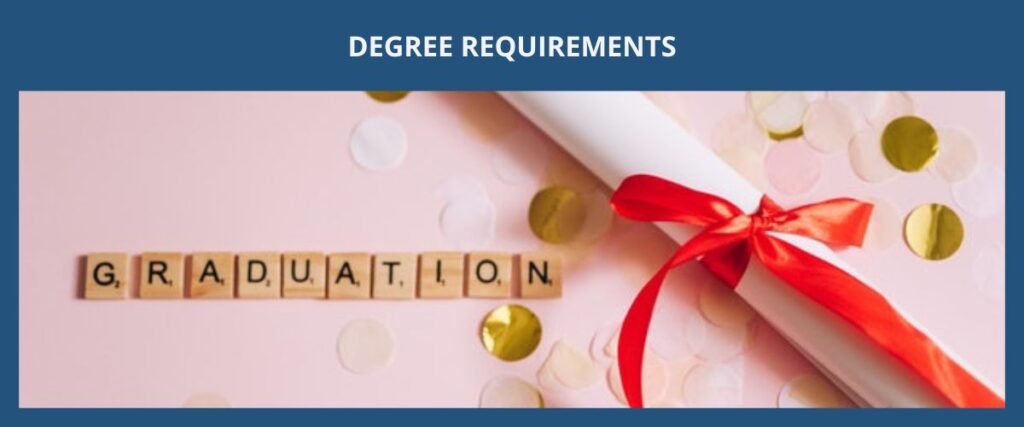
A qualified H1B visa job position must be in a specialty occupation which requires (1) theoretical and practical application of a body of highly specialized knowledge, and (2) at least a bachelor’s degree (or its equivalent) in the specific specialty field to enter that occupation in the United States.
Required Degree in Specific Specialty
The required degree must be in a specialty field that is related to the job position which means that the classes completed for the degree should have provided the person with the knowledge and skills that are necessary to perform the specific job position. For example, a public relations job position that accepts workers with a degree in a general field (e.g., business administration) or degrees in a variety of fields (e.g., marketing or advertisement major) will more likely face challenges than a software engineer position that accepts workers with a computer science degree due to the public relations job position not requiring a degree in a specific field.
Qualified Specialty Occupation
The qualified specialty occupation under the H1B visa must also satisfy at least 1 of the 4 requirements: (1) a bachelor’s degree or a higher degree (or its equivalent) is normally the minimum requirement for the job position, (2) the degree requirement is common for similar employers in the industry or alternatively the job position is so complex or unique that it can only be done by a person with a degree, (3) the employer normally requires a degree (or its equivalent) for the job position, or (4) the nature of the specific duties is so specialized and complex that the knowledge required to perform the job duties is usually associated with having a bachelor’s degree or a higher degree.
The original statutory language for the requirements can be found under 8 CFR §214.2(h)(4)(iii)(A).
Degree is Normally a Minimum Requirement for Job Position
The H1B visa job position should normally require at least a bachelor’s degree in a specific specialty related to the job duties that the worker would need to perform. The specific field of study should be directly related to the job duties of the H1B visa job position. Thus, job positions that accept a generalized degree (e.g., business administration without a concentration) or degrees from a variety of specialty fields may face issues under the H1B visa.
Degree is Normally a Minimum Requirement for Job Position
The factors of whether the job position is qualified as a specialty occupation under the H1B visa can include but are not limited to:
- Job title
- Job duties (this will be the focus)
- The H1B visa worker’s education and work experience
- The nature of the U.S. employer’s business operations (e.g., size of business, the industry it is in)
- Salary that is offered to the H1B visa worker and what is common in the industry
- Common industry practices
Degree is Normally Required in Industry or Job Duties are Specialized and Complex
The degree requirement for the H1B visa job position should be considered common practice with other similar employers in the same industry. The U.S. sponsoring employer under the H1B visa should be compared to other employers in the industry that are similar in size, level of revenue, or the number of employees.
Employer Normally Requires the Degree
The H1B visa job position can also qualify as a specialty occupation if (1) the U.S. sponsoring employer usually required that degree in the past, (2) the H1B visa job position itself requires the degree, and (3) theoretical and practical application of a body of highly specialized knowledge is required to perform the job duties.
The U.S. sponsoring employer’s past employment (hiring and recruitment) practices for the H1B visa job position (or similarly situated employees) will be looked at and the educational background, work experiences, and job duties of the past employees that held the H1B visa job position will be reviewed. For example, if a previous employee who held the proposed H1B visa job position did not have a bachelor’s degree, it would unlikely for this job position to qualify under the H1B visa.
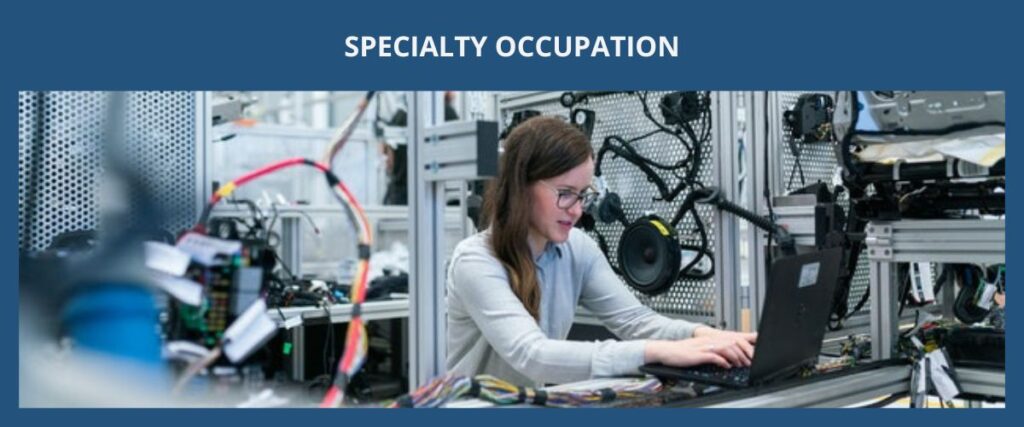
The initial H1B visa grants a period of stay up to 3 years (or to the validity period authorized by the LCA) and the renewals (extensions of stay) are granted for up to an additional 3 years until the maximum limit of 6 years is reached. Any time spent physically outside the United States or under any other nonimmigrant visa status (except the H1B visa or L1 visa) while in the United States can be recaptured for the maximum limit of 6 years of the H1B visa status. After the maximum 6 years of the H1B visa is reached, the person must remain physically overseas (outside the United States) for at least 1 year before filing for a new H1B visa petition.
The exceptions to the H1B visa 6-year limitation are when the person:
- Falls under the American Competitiveness in the 21 Century Act (AC21) where the H1B visa worker’s PERM labor certification request, green card petition (Form I-140), or adjustment of status (Form I-485) is pending
OR
- Resides overseas and commutes regularly to the United States for part-time employment
OR
- Did not reside continually in the United States and the employment in the United States was intermittent, seasonal, or was in total six months or less per year
The exceptions (excluding the AC21 scenario) cannot be used if the H1B visa worker’s dependent family members resided continuously in the United States under their H4 visa status.
Previously Held L1 Visa Status and H1B Visa Status
For persons who have held an L1 visa status before their H1B visa status, the time they were under the L1 visa status will be counted toward the maximum time limit of the H1B visa status. For example, if the person spent 1 year in an L1A visa status and then changed into an H1B visa status, the person’s maximum time on their new H1B visa status would be 5 years (the 1 year in L1A visa status takes away 1 year from the H1B visa’s 6-year maximum limit) instead of 6 years.
Additional Periods of Authorized Stay (H1B Visa Grace Period)
The H1B visa worker is allowed to enter the United States 10 days before the start date and stay an additional 10 days after the end date (which should be included on the Arrival/Departure Records Form I-94). However, the H1B visa worker cannot work in those additional 20 days.
There is also a 60-day grace period of authorized stay in the United States if the H1B visa worker’s employment is terminated before the visa end date. The 60-day grace period can only be used once during each authorized validity period and cannot be added up (which means the 60 days cannot be split up into multiple periods of time). For example, an H1B visa worker with an approved 3-year H1B visa validity cannot use the grace period for 10 days and then later use another 50 days during those 3 years (i.e., the one-time 60-day grace period is seen as being used up after the first use of the 10 days under this situation). Typically, a new grace period can be available when the H1B visa worker changes to a new employer or their H1B visa is extended.

Certain H1B visa workers can extend their H1B visa beyond the 6-year maximum limitation in 1-year or 3-year increments under the AC21 and/or 21st Century DOJ Appropriations Authorization Act if the H1B visa worker satisfies 1 of the 4 following scenarios:
- (1)
- The H1B visa worker who has a PERM labor certification or green card petition (Form I-140) that was filed before the end of the 5th year of their H1B visa status can extend their H1B visa status in 1-year increments.
- (2)
- The H1B visa worker who has a PERM labor certification or green card petition (Form I-140) that has been pending for more than 365 days can extend their H1B visa status in 1-year increments.
- (3)
- The H1B visa worker who has a green card petition (Form I-140) pending for more than 365 days since the date that their PERM labor certification was filed with the DOL can extend their H1B visa status in 1-year increments.
- (4)
- The H1B visa worker who has an approved green card petition (Form I-140) but their immigrant visa (green card) is not available because of the per country (or worldwide) limitations can extend their H1B visa status in 3-year increments. (For example, persons born in India, China or Mexico.)
U.S. Employer Can Be Different
The employer filing the H1B visa extension does not need to be the same employer as in the PERM labor certification or the green card petition (Form I-140). The H1B visa extensions filed beyond the 7th year do not need to use the same PERM labor certification application or green card petition that was used for the first H1B visa extension filed beyond the 6th year.
H1B Visa 7th Year
The H1B visa extension petitions beyond the 6th year can (1) be filed up to 6 months before the requested H1B visa extension start date (which should be at least 365 days since the H1B visa worker’s PERM labor certificate application or green card petition was filed), (2) be filed before the required 365 days has actually elapsed as long as the required 365 days will be satisfied before the requested start date of the H1B visa extension, and (3) include any time that is remaining of the maximum 6-year limit (recapturing H1B visa time).
Filing While Not Under H1B Visa Status
The H1B visa worker who has an H1B visa extension petition filed for them beyond the 6-year limitation can be outside the United States and do not need to be currently under an H1B visa status, however, they are required to file for an adjustment of status or for consular processing within 1 year of their immigrant visa (green card) becoming available.
The initial H1B1 visa (for Chile or Singapore nationals) grants a period of stay up to 1 year and the renewals (extensions of stay) are granted in 1-year increments. LCA should be filed every 3 years. There is no maximum limit on how many times the H1B1 visa can be renewed or how long a person can hold an H1B1 visa status.
-eng-1024x427.jpg)
The H1B visa for the professionals in specialty occupations have three main requirements that needs to be satisfied: evidence must be provided to the USCIS to show that (1) the job position offered under the H1B visa petition qualifies under the definition of a specialty occupation (which is a professional job position that requires at least a Bachelor’s degree (or its equivalent) to conduct theoretical and practical application of a body of highly specialized knowledge, (2) the H1B visa worker has the qualifications to work in that job position (which typically means that the H1B visa worker has a Bachelor’s degree in that specific field or has the equivalent work experience), and (3) the U.S. sponsoring employer has the business need and ability for such a H1B visa worker.
Documents Required for the H1B Visa (Specialty Occupation)
The evidence provided to the USCIS for the H1B visa (Specialty Occupation) must show:
- (A)
- The job offered must be in a specialty occupation which is shown by meeting at least one of the following:
The original statutory wording for the evidentiary requirements of the H1B visas can be found in 8 CFR 214.2(h)(4)(iii) and 8 CFR 214.2(h)(4)(iv).

The H1B visa filing fees to the U.S. government include:
- H1B visa registration fee (lottery): $10
- H1B visa petition (Form I-129): $460
- U.S. consulate or embassy nonimmigrant visa appointment fee (DS-160): $160
- H1B visa fraud prevention and detection fee: $500
- H1B visa ACWIA education and training fee:
- $750 if the U.S. sponsoring employer has 25 or less full-time employees (or equivalent)
- $1500 if the U.S. sponsoring employer has more than 25 full-time employees (or equivalent)
- H1B visa public law 114-113 fee: $4000 (for U.S. sponsoring employers that have 50 or more employees and over 50% are those employees are under an H1B visa or L1 visa)
- Premium processing (Form I-907): $2500 (optional)
Full-time employees that are working in a U.S. affiliate or subsidiary of the U.S. sponsoring employer are included under the 25 full-time employees calculation.
*The fraud fee does not apply to H1B visa extensions with the same U.S. sponsoring employer, or to H1B visa petitions filed by certain schools (and its affiliated or related nonprofit organizations) or nonprofit (or governmental) research organizations.

There are 3 main steps in the general process of obtaining an H1B visa:
Step 1: Job Offer for a Qualified H1B Visa Job Position from U.S. Sponsoring Employer
The H1B visa worker must receive a job offer that falls under a qualified H1B visa specialty occupation (i.e., a professional job position that requires at least a Bachelor’s degree) from a U.S. employer. The U.S. employer must also be willing to sponsor (pay for and initiate) the H1B visa petition for the person which means that the H1B visa worker cannot self-sponsor themselves for an H1B visa.
Multiple H1B Visa Filings
The U.S. employer cannot file multiple H1B visa petitions for the same foreign worker to increase the chances of the person being selected in the lottery system. However, the foreign worker can have different U.S. employers file separate H1B visa petitions for them if the U.S. employers are not considered “related” and there is a legitimate business need for the H1B visa worker.
Step 2: Registering for the Lottery System (if Required that Year), Obtaining an Approved LCA Certification (Form ETA-9035), and Filing the H1B Visa Petition (Form I-129)
The U.S. sponsoring employer must first register the H1B visa worker to enter the H1B visa lottery system in the Spring (typically during March) if it is required that year (this happens when the number of H1B visa petitions filed exceeds the amount of H1B visas that can be given out that year).
The H1B visa lottery system will then randomly select the H1B visa petitions that can continue on to be reviewed by the USCIS. If the H1B visa worker’s petition is selected, the U.S. sponsoring employer will then file for a labor condition application (LCA) certification (Form ETA-9035) with the DOL to obtain wage determination. After the LCA is certified, the U.S. sponsoring employer can then file the H1B visa petition (Form I-129) with the USCIS.
Labor Condition Application (LCA)
The employer must have an approved Labor Condition Application (LCA) from the U.S. Department of Labor (DOL). The LCA is filed before the H1B visa petition is filed with the USCIS and a copy of the certified LCA should be given to the H1B visa worker before they start working. The LCA includes information such as the position title, wage, employment dates, location, the source used for determination of the prevailing wage, and the U.S. employer’s attestation that:
- The H1B visa worker’s wage will be at least the same as the actual wage the employer pays to other similarly employed workers OR the local prevailing wage for the position.
- The working conditions (e.g., hours, fringe benefits, vacation time) of other similarly employed workers in the area will not be affected adversely.
- There is no strike or lockout at the proposed workplace.
- The LCA has been provided to the union or it has been posted at the proposed workplace in at least 2 conspicuous locations (or through electronic posting on intranet/electronic bulletin boards or a direct one-time email to affected employees) for a period of 10 days within the 30-day period before filing the LCA with the DOL.
If a strike, lockout, or work stoppage due to a labor dispute happens at the H1B visa work location, the U.S. sponsoring employer is required to notify the Employment and Training Administration within 3 days and must stop the work of the H1B visa worker at that location. There are fines, prohibitions on filing future visa petitions, and/or random investigations on U.S. employers who are found to be willful violators of the LCA certification.
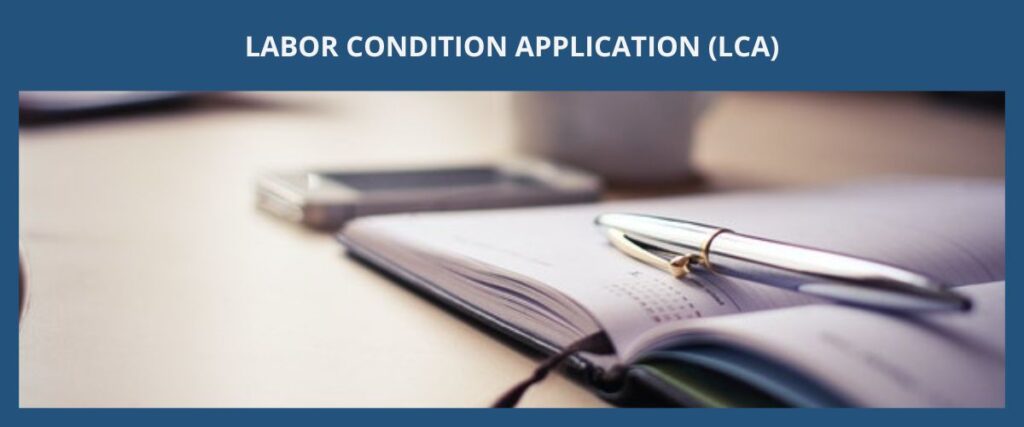
Prevailing Wage and Actual Wage Determination
The U.S. employer sponsoring the H1B visa petition is required to pay the H1B visa worker the prevailing wage or the actual wage paid to other similarly employed workers (whichever is higher).
Prevailing Wage Determination
The prevailing wage is the average rate of wages paid to workers employed in a similar capacity in the area where the H1B visa worker’s employment is intended. The National Prevailing Wage Center (NPWC) uses factors such as job title, job description, required education and work experience, location, and employer type (i.e. private corporations, government, academic) to determine the prevailing wage. For example, the same exact job offered in San Francisco, California would likely have a higher prevailing wage than in Champaign, Illinois due to the cost of living in the respective locations.
For academic or research job positions at schools of higher education (or their affiliated or related nonprofits), nonprofit research organizations, or governmental research organizations, the prevailing wage only looks at the wages given at similar institutions in order to avoid requiring academic institutions to match the salaries given in the private industry.
Actual Wage Determination
The actual wage is the amount the U.S. employer pays other employees who are similarly employed and have similar qualifications and experiences. The U.S. employer is also required to give the H1B visa worker the same benefits offered to other similarly situated employees.
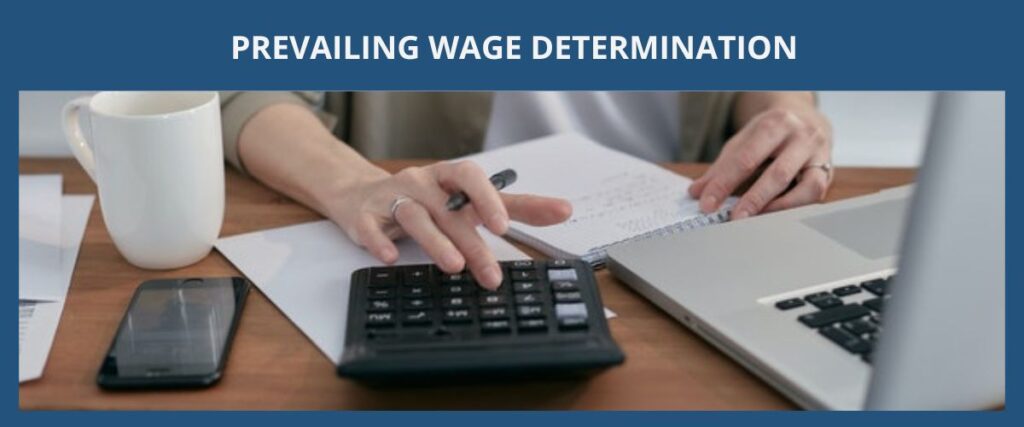
H1B Visa Public Access File
The U.S. employer should have a public access file of the H1B visa petitions, which includes but is not limited to:
- LCA certification (should include cover pages, U.S. employer’s original signature and the H1B visa worker’s signature to show that they received a copy)
- Prevailing wage determination (from NPWHC, survey, or other sources that were used)
- Documents that show the wage given to the H1B visa worker (such as an offer letter)
- Notice given to union
- Explanation of how the actual wage was determined
- Summary of benefits offered to the H1B visa worker (should show that it is the same as what is given to other similarly employed U.S. workers)
Employers who are H1B visa dependent employers or willful violators are subjected to additional attestations if the H1B visa worker is not qualified as an exempt H1B visa worker (i.e., non-exempt H1B visa workers are workers who are paid less than $60k annually and does not have at least a master’s degree).
Exempt H1B Visa Worker
An exempt H1B visa worker is a person who (1) has an annual wage of at least $60, 000 (includes cash bonuses and similar compensations), or (2) has at least a master’s degree.
Employers that are H1B visa dependent employers or willful violators (1) cannot have displaced (lay off) similarly situated U.S. employees from 90 days before filing the LCA and 90 days after filing the H1B visa petition, and (2) must have made good faith efforts to recruit U.S. workers for the H1B visa position (which should include internal, external and some active recruitment efforts done). The displacements of similarly employed U.S. workers also cannot happen with another employer if the U.S. employer is placing the non-exempt H1B visa worker with that employer.
H1B Visa Dependent Employer
The employer is seen as an H1B visa dependent employer if:
- There are more than 7 H1B visa workers in a company that has 25 or fewer full-time employees
- There are more than 12 H1B visa workers in a company that has 26 to 50 full-time employees
- There are at least 15% of H1B visa workers in a company that has 51 or more full-time employees
Calculation of Employees
Part-time employees can be counted as (1) half of a full-time employee or (2) the total amount of part-time hours can be divided by the full-time hours rounded up to the nearest whole number. Independent contractors or consultants are not included under the definition of employee under the H1B visa dependent employer calculations.
U.S. sponsoring employers that are one of the multiple entities within a controlled group of corporations treated as a single employer by the IRS must also use the single employer definition in the H1B visa dependency calculations.
Employer is Willful Violator
The employer is seen as a willful violator if the employer misrepresented or committed a willful failure in complying with the LCA certification within the previous 5-year period.
Additional Documents for H1B Visa Dependent Employers or Willful Violators
Additional documents are required when the U.S. sponsoring employer is determined an H1B visa dependent employer or a willful violator:
- If there are non-exempt H1B visa workers under the labor condition application (LCA), a summary of recruitment methods (which includes the time frames of the recruitment or related documents) must be provided.
- If there are only exempt H1B visa workers under the labor condition application (LCA), a list of the individuals employed must be provided.
Additional Documents for Employers After Change in Corporate Structure
Additional documents are required when there has been a change in the corporate structure of the U.S. sponsoring employer:
- Sworn statement from a representative of the new organization that all responsibilities under the predecessor’s LCA are accepted
- FEIN of the new organization
- List of affected LCA and its certification dates
- Description of the new organization’s actual wage system
Benching
The U.S. sponsoring employer cannot bench an H1B visa worker (or H1B1 visa worker, E3 visa worker) by taking the employee off active employment and not paying the visa worker (or paying less than their full wage). Benching can happen in situations such as when the U.S. sponsoring employer experiences slow business or when it is not able to obtain certain permits or licenses to do business, or when the foreign worker does not have a social security number (SSN).
Benching does not apply if the foreign worker is not in active employment because of non-work-related reasons that made them unable to work or voluntary requests to not work made by the foreign worker. For example, benching does not apply to situations such as when the foreign worker had surgery and is recovering, maternity leave, taking care of a sick relative, or touring the United States.
Liquidated Damages
The U.S. sponsoring employer cannot penalize the H1B visa worker for leaving to work for another employer, however, it can require the employee to sign an employment contract that contains a liquidated damages clause if permitted under state law.

Step 3: Consular Processing or Change of Status (H1B Visa)
After the USCIS approves the H1B visa petition (Form I-129), the person will then need to change into their H1B visa status. There are 2 ways to change into the H1B visa status: change of status (done in the United States) and consular processing (done outside of the United States).
Change of status is usually for a person who is already in the United States with another valid nonimmigrant visa status and has maintained a lawful visa status throughout their time in the United States. On the other hand, consular processing is for a person who lives outside the United States or for a person who is ineligible to change their status in the United States due to noncompliance of U.S. immigration law (e.g., overstayed on their previous visa status, worked when they did not have valid U.S. work authorization, the visa status they used to enter the United States does not allow them to change into another type of visa status, etc.)
Person Outside U.S. (or Person Ineligible for Change of Status)
For a person who is residing overseas (outside the United States) or a person who is ineligible for change of status with the H1B visa petition (Form I-129), consular processing must be done to obtain the H1B visa status. Consular processing involves the person attending an in-person interview at the U.S. consulate or embassy usually in the person’s home country. In certain circumstances, a person can do consular processing in another country as a “Third Country National.”
After the interview approval at the U.S. consulate or embassy, the person would have to be admitted entry into the United States by the CBP officer at the border (usually at the airport) which means that the person would have to physically enter the United States as the final step for the H1B visa status to be activated.
Person Residing in the U.S. (Maintained Lawful Visa Status)
For a person who is already in the United States with another valid nonimmigrant visa, there are usually two options available to obtain the H1B visa status:
(1) Change of Status: this is the more commonly chosen option where the person states that they would like to change their status without leaving the United States in their H1B visa petition (Form I-129). If the person is eligible (no violations of U.S. immigration laws), then their nonimmigrant visa status will be changed upon the approved employment start date listed in the H1B visa petition. In cases where the person’s change of status request is denied or the person needs to change it into consular processing, an application for action on an approved application or petition (Form I-824) may be required.
(2) Consular Processing: this must be chosen if a person cannot show that they have maintained lawful visa status in the United States or for any other reasons such as the person needs to travel internationally before the H1B visa petition is approved.
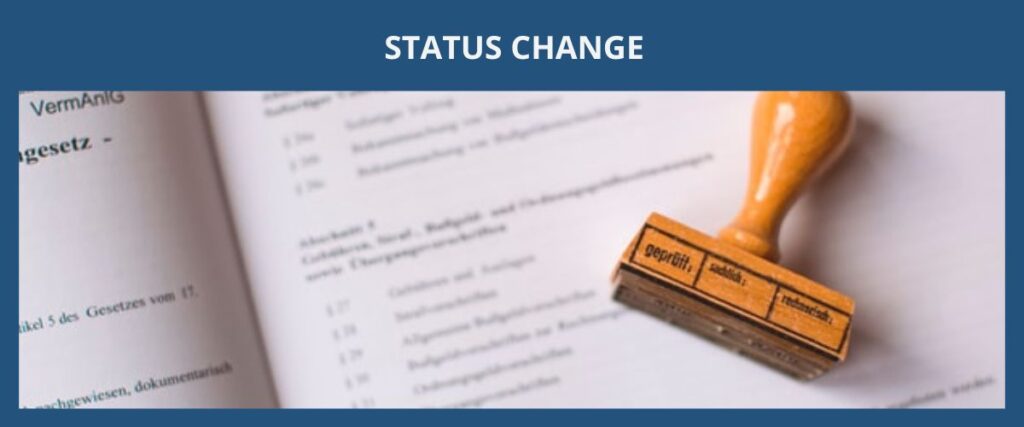
The total time an H1B visa takes is consisted of the processing time for the (1) H1B visa petition (Form I-129) with the USCIS and the (2) visa application (DS-160) at a U.S. consulate or embassy overseas if the person is not already in the United States or is ineligible to do a change of status within the United States.
A rough estimate for the Form I-129 petition for the H1B visa is around 2 to 7 months. The most current estimate of the processing time can be found here. Factors that influence the H1B visa petition processing time usually include but are not limited to if there was any Request for Evidence (“RFE”) issued, and the caseload of the USCIS service center and the U.S. consulate or embassy.
Premium Processing for Form I-129 (Expedited Service)
A rough estimate for the Form I-129 petition for the H1B visa is around 2 to 7 months. However, a 15-day premium processing (Form I-907) is available for the Form I-129 part of the H1B visa petition. Premium processing is an optional expedited service where the USCIS guarantees that the case will be processed within 15 calendar days (not business days). When a notice of intent to deny (NOID) or a request for evidence (RFE) is issued, a new 15 calendar days will start when the USCIS receives a response from the applicant. If the USCIS fails to process within the time frame, a refund of the service fee will be given and the case will continue to be expedited. Please note that USCIS’s guaranteed response may be an approval notice, denial notice, notice of intent to deny (NOID), request for evidence (RFE), or open an investigation for fraud or misrepresentation.
The current premium processing fee for the H1B visa is $2500 USD and it can be requested when the original petition is submitted to the USCIS or an upgrade to premium processing can be done when the case is pending.
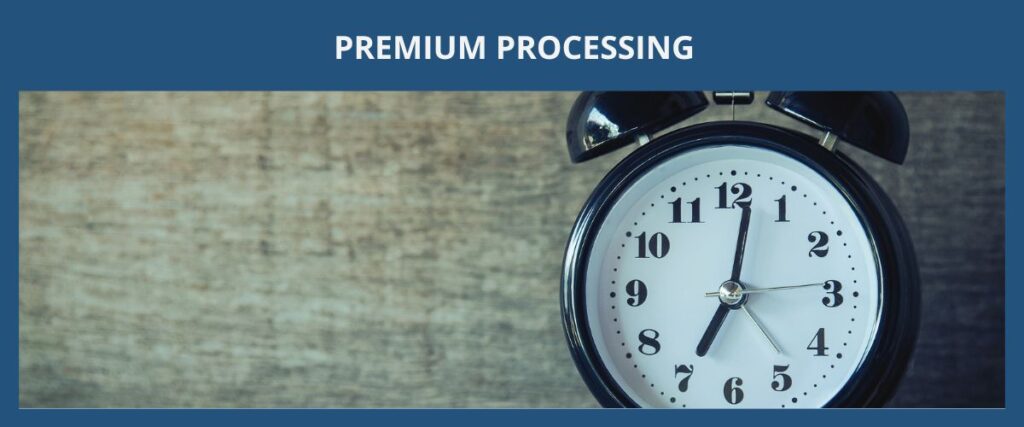
A change in employment for the H1B visa worker usually means that (1) the person will be working for another employer, (2) the person will be working for multiple employers at the same time, (3) the person’s employment was terminated earlier than expected, (4) the person will change from working full-time to working part-time, (5) the person will be changing work locations short-term, or (6) there was a material change in the person’s employment or H1B visa eligibility.
If the H1B visa worker changes to a new employer, a new H1B visa petition must be filed by the new employer and it will not be subject to the cap restriction (which means it does not need to go through the lottery system again and can be filed during any time throughout the year).
The H1B visa has a portability rule where the H1B visa worker can start working for the new employer as soon as USCIS receives the filing of the new H1B visa petition (as opposed to most work visas where the person must wait until the new visa petition is approved to start working for the new employer). However, if the new H1B visa petition is denied, work authorization under the portability rule stops and the H1B visa worker must leave the United States immediately because no grace period is given. The portability rule can also be used during periods of authorized stay such as grace periods or periods where previous H1B visa petitions are still pending.
H1B visa workers who used the portability rule to work for a new employer but their new (change of employer) H1B visa petition was denied can go back to work for their previous employer if that previously approved H1B visa is still valid.
*Please note that the portability rule cannot be used for H1B1 visa petitions (i.e., H1B1 visa workers from Chile or Singapore).
Bridging H1B Visa Petitions
An H1B visa worker who already has a pending change of employer H1B visa petition filed for them can continue to have additional new change of employer H1B visa petitions filed for them. Bridging H1B visa petitions means that the H1B visa worker uses the portability rule to bridge multiple pending H1B visa petitions to maintain their authorized stay in the United States. However, if any H1B visa petition in that bridge (string of filings) is denied, the bridge (authorized stay) will be broken and the H1B visa petitions filed after that denied H1B visa petition (that broke the bridge) will also be denied unless the H1B visa worker’s current H1B visa status is still valid.
In other words, if the H1B visa worker was in a valid H1B visa status when a later H1B visa petition was filed and has remained in that valid H1B visa status (i.e., the validity period of the original H1B visa status have not expired), the later filed H1B visa petition can still be approved even if an earlier H1B visa petition was denied.
The H1B visa worker can work (part-time or full-time) for multiple employers at the same time but each employer must file a separate H1B visa petition for the H1B visa worker.
Concurrent Employment of Cap-Exempt and Cap-Subject H1B Visas
The H1B visa worker can work for a cap-exempt H1B visa employer and a cap-subject H1B visa employer at the same time. If the H1B visa worker obtained their cap-exempt H1B visa first and then later filed to start work with an H1B visa cap-subject employer, the H1B visa worker would not need to be counted toward the cap which means that the later filed cap-subject H1B visa petition would not need to go through the initial H1B visa petition process (that typically includes the lottery system).
However, the H1B visa worker under the cap-exemption would still need to maintain the employment with their H1B visa cap-exempt employer and must be able to reasonably work for both employers at the same time. If the H1B visa worker’s cap-exempt employment ends, then the concurrent cap-subject H1B visa employment will end as well (unless this cap-subject H1B visa was separately counted toward the numerical limit in its initial petition process which typically means it went through the lottery system).
Amended Petition
An amended H1B visa petition would be required if there is a material change in the terms and conditions of the H1B visa worker’s employment or in the H1B visa worker’s visa eligibility. For example, an amended H1B visa petition would need to be filed if the H1B visa worker changed into a different type of specialty occupation, or if the H1B visa worker’s work location changed to another location that is outside the geographical area listed in the LCA application with the DOL.
H1B visa employers that went through a corporate restructuring (e.g., merger, acquisition, consolidation) and their interests and obligations were succeeded by a new corporate organization do not need to file an amended H1B visa petition or new LCA for current H1B visa workers if the only change was the identity of the H1B visa sponsoring employer (i.e., employment terms and conditions are still the same).
Change of Work Location (Short-Term Placement Rules)
When the H1B visa worker changes work locations that is outside of the normal commuting distance of the “area of employment” listed in the LCA, the U.S. employer would typically need to either (1) comply with the short-term placement rules under the H1B visa or (2) file a new LCA for the new work location and amended H1B visa petition with the USCIS.
Short-Term Work Location (30 Days or 60 Days)
The H1B visa worker can travel to another work location not covered by the LCA for up to 30 days or 60 days each year under the short-term placement rule. However, the short-term placement cannot be in a place where the U.S. employer already has a certificated LCA for the specialty occupation classification or the U.S. sponsoring employer would need to use an available open slot under an LCA (or file a new LCA if there are no open slots) for the H1B visa worker to work at that new work location.
The 60-day short-term placement is permitted if (1) the H1B visa worker maintains a workplace at the permanent worksite and spends a significant amount of time there within the year, and (2) has a place to live (i.e., home) within the area of the permanent worksite.
Reposting LCA Notice
For the H1B visa workers who will be changing to a work location that is still within the area of employment listed in the LCA, the U.S. employer must repost the LCA at the new work location before the H1B visa worker starts working at that location.
Occasional Traveling
H1B visa workers who travel occasionally and do not spend more than 10 days at a new location will not need to file a new LCA or an amended H1B visa petition. H1B visa workers who must travel constantly (peripatetic workers) under their normal job duties cannot spend more than 5 days in one location.
Early Termination
If the H1B visa worker’s employment ends before their visa status expiration date, the person will have a 60-day grace period (or till their existing expiration date if it comes earlier) to stay in the United States to seek other employment, change their visa status, or take care of affairs before departing the United States. However, the H1B visa worker is not allowed to work during that 60-day grace period.
If the H1B visa worker’s employment was terminated involuntary (e.g., the H1B visa worker did not voluntarily resign) before their visa status expiration date, the sponsoring employer or agent would have an obligation to pay a reasonable transportation cost to the H1B visa worker to return to their last place of residence before coming to the United States.
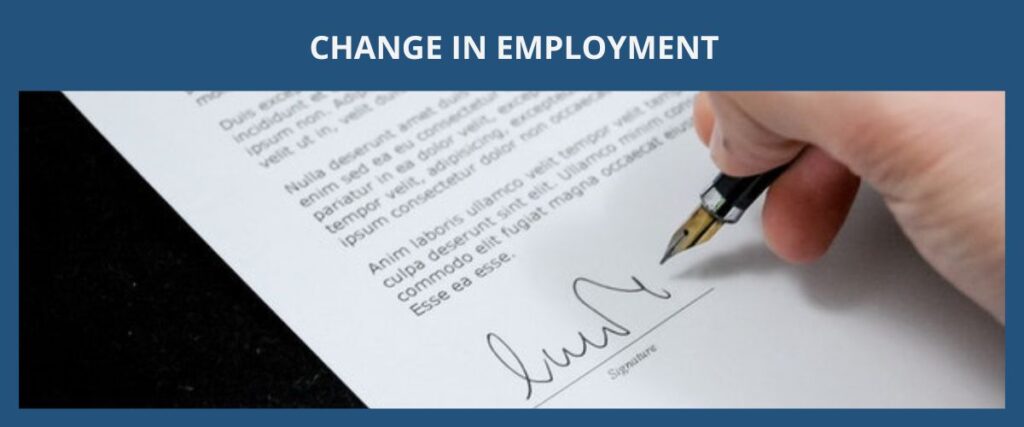
Dependent family members (spouse and unmarried children under 21 years old) of H1B visa workers are allowed to stay in the United States under the H4 visa status.
The H4 spouse (not the H4 child) can work with an employment authorization document (EAD, Form I-765) if the H1B visa worker (1) has an approved green card petition (Form I-140) or (2) maintains an extended H1B visa status beyond the 6-year limit under the AC21 §106(a) and (b) which includes H1B visa workers who have a PERM labor certification application or green card petition (or application) pending for more than 365 days or under the AC21 §104(c) is waiting to change into a green card status with as adjustment of status or consular processing due to per country limitations.
The H1B visa is a dual intent visa whereas the H1B1 visa is a limited dual intent visa. Dual intent visas allow the foreign person to have both an intent to temporarily stay in the United States and an intent to permanently stay in the United States. The intention to permanently stay in the United States can be shown when the foreign person has a pending green card petition with the USCIS or an approved PERM labor certification from the U.S. Department of Labor.
H1B Visa Dual Intent
The H1B visa is a dual intent visa which means that it is possible for the person to have a green card (permanent residency) petition pending while still being able to maintain and extend (renew) their H1B visa status in the United States.
H1B1 Visa Limited Dual Intent (Chile and Singapore Nationality)
Unlike the dual intent H1B visas, the H1B1 visas for Chile or Singapore nationals are limited dual intent visas which means that the timing of any green card application or petition must be carefully strategized.
Showing Immigrant Intent
An H1B1 visa worker is required to show nonimmigrant intent (that their stay is temporary) when they are applying for an H1B1 visa at the U.S. consulate overseas and at the time of their admission (when they enter) to the United States, however, it is not statutorily required when the H1B1 visa worker is filing to extend (renew or change employers) their H1B1 visa status with the USCIS while physically in the United States.
This difference in the terms of the statutes may cause different outcomes for an H1B1 visa worker who has a pending green card petition (i.e., showing immigrant intention) but needs to maintain their H1B1 visa status. For example, the H1B1 visa worker with a pending green card petition will likely be denied an extension (renewal) of their H1B1 visa at the U.S. consulate overseas but will likely be approved if the person stayed in the United States and had that request filed with the USCIS.
Issues With International Travel
Another issue that may arise when the H1B1 visa holder shows an immigrant intent is when they return to the United States after traveling internationally because the H1B1 visa worker is required to show that they do not have the intention to remain or work permanently in the United States. So, unlike visas (e.g., H1B visa, L1 visa) that allow dual intention, H1B1 visa workers should be much more cautious when deciding whether they must travel internationally after they file for a green card (immigrant visa) petition.
H1B visas are temporary work visas commonly used by foreign persons working in specific professional job positions that require a Bachelor’s degree.
The most common scenario under the H1B visa is where a F1 visa student graduates from a U.S. college or university with a Bachelor’s degree or an advanced degree (e.g., Master’s degree, Ph.D., MD, JD) and during their OPT is working for a U.S. employer that is willing to sponsor a H1B visa petition for them to continue working there. In some scenarios, the U.S. employer files a H1B visa petition for a F1 visa student while they are still attending school but have already completed all requirements of a qualifying degree.
eng-1024x427.jpg)
The H1B visa cap-gap rule is to extend work authorization for the F1 visa students whose OPT will expire before they can start to work on their H1B visa. The main purpose of the H1B visa cap-gap rule is to avoid disruption of employment for the F1 visa student and their U.S. employer.
Qualified F1 Visa Student for H1B Visa Cap-Gap Rule
The H1B visa cap-gap rule allows an F1 visa student who (1) is working under an approved OPT and (2) has an H1B visa petition filed for them by a U.S. employer (while their OPT was still valid) to continue to legally work (based on their approved OPT) until October 1 of that same year (which is the earliest start date for an approved H1B visa). If the H1B visa petition is still pending on (or after) October 1 of that year, the F1 visa student can still stay in the United States to wait for their H1B visa petition to be determined but they must stop working.
Filing for H1B visa Cap-Gap Rule
The H1B visa cap-gap rule applies when the H1B visa petition (Form I-129) is timely filed with the USCIS which means that just selection for the H1B visa registration (receiving the H1B visa selection notice) is not enough. In addition, F1 visa students using the H1B visa cap-gap rule to change their status should not travel internationally before their H1B visa petition is still pending (before approval) because it will be seen as them abandoning their request and their OPT employment authorization documents (EAD) will be expired.
OPT Work Authorization Extension (Valid OPT)
For F1 visa students to continue legally working on their OPT until they change into an H1B visa status under the H1B visa cap-gap rule, the F1 visa student’s OPT must be valid (not expired) on the H1B visa petition filing date. The H1B visa petition must be timely filed and the F1 visa student should not have violated any terms and conditions of their nonimmigrant visa status.
STEM students can file for their OPT STEM extensions during the H1B visa cap-gap extension period. F1 visa students are also allowed to change employers during their H1B visa cap-gap time but must avoid being unemployed for 90 days (or 150 days for STEM extensions).
Authorization to Stay (Expired OPT but in 60-day Grace Period)
If the F1 visa student’s OPT has already expired and the F1 visa student was in their 60-day grace period (following their OPT end date) when the H1B visa petition was filed, then the F1 visa student is only allowed to remain in the United States unemployed (cannot work) to wait for their H1B visa petition to be determined (which may result in the F1 visa student starting work on October 1 of that year if their H1B visa petition is approved or the F1 visa student may be required to leave the United States earlier than October 1 of that year if their H1B visa petition is denied).
H1B Visa Cap-Gap Extension Ends Early
If the H1B visa petition is rejected, denied, revoked, or withdrawn, the H1B visa cap-gap extension will end and the F1 visa student will enter their 60-day grace period.
International Traveling During H1B Visa Cap-Gap
The F1 visa student should not travel internationally (leaving the United States) when their H1B visa petition (with a change of status request) is still pending because it will be seen as an abandonment of the change of status request and the H1B visa cap-gap relief. However, if the F1 visa student’s H1B visa petition has been approved and they still have a valid F1 visa stamp, then international travel should be allowed during the H1B visa cap-gap extension.
H1B Visa Revoked but has Valid OPT
When F1 visa students who are on their OPT has an approved H1B visa petition (and requested for a change of status in the United States) lose their job before the H1B visa start date can continue to work if their OPT is still valid (unexpired) but the U.S. sponsoring employer who filed the H1B visa petition must file a withdrawal of the H1B visa petition with the USCIS and the F1 visa student must provide a copy of the USCIS acknowledging the withdrawal to the DSO at their school (typically international students department) so that they will still be on an F1 visa status after the previously approved H1B visa start date.
If the H1B visa petition is revoked after October 1, the F1 visa student must stop working immediately and can only resume to work after the reinstatement application (Form I-539) is approved.
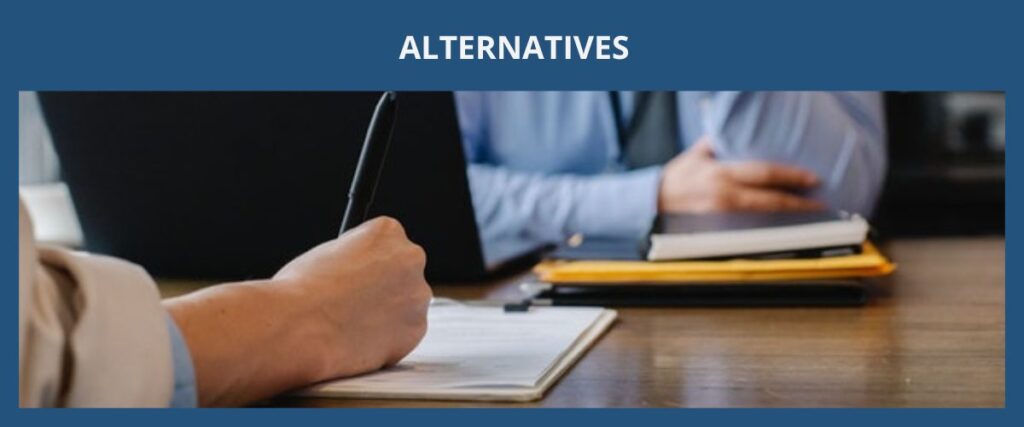
The closest alternatives to the H1B work visa petition would be filing for an L1B visa petition which is for employees who have specialized knowledge of the multinational company, or O1 visas which is for people who have an extraordinary ability in the sciences, arts, education, business, or athletics. Similar work visas to the H1B visas that are for people from certain countries include E3 visas for Australians working in specialty occupations and TN visas for Canadian or Mexicans working in certain professional occupations.
Another possible alternative to filing an H1B visa petition would be to file for a green card petition which is a permanent immigrant visa and not a temporary work visa like the H1B visa. Typically, a person who is qualifiable for an H1B visa would choose to file for an EB2 green card (which are usually for people who has at least a master’s degree) or EB3 green card (which are usually for people who has at least a bachelor’s degree) due to certain similarities in the requirements. For more on green cards gained through work, please read the overview for employment-based green cards.
The main difference between a green card and a temporary work visa (such as an H1B visa, L1 visa, O1 visa, P1 visa, TN visa, E3 visa) is that a green card holder can freely change jobs among different employers without needing additional filings or approvals from the U.S. government. Also, unlike temporary work visas, green cards are permanent so there is no set maximum time on how long a green card holder can stay in the United States.
When the H1B visa workers decide that they would like to live in the United States permanently and do not want to be subject to the time limitations or the constant filing requirements to extend (renew) their temporary work visa, the next step for them is to file a green card petition. Typically, a person who is qualifiable for an H1B visa would choose to file for an EB2 green card (for persons who have at least a Master’s degree), or an EB3 green card (for persons who have at least a Bachelor’s degree). Both EB2 green cards and EB3 green cards require a PERM labor certification from the U.S. Department of Labor (“DOL”) unless they fall under certain exceptions. One of those exceptions is when the person’s employment benefits the interests of the United States as a nation and a national interest waiver is filed with the EB2 green card petition (“EB2 National Interest Waiver”).
Furthermore, a person can qualify for an employment-based green card no matter where they are currently residing in the world. There is no pre-requisite as to the person being in some type of nonimmigrant visa status (such as an H1B visa) or having an educational degree from a U.S. school. In other words, a person who does not have a U.S. degree and has never been to the United States can still qualify for an employment-based green card. Thus, even if a person is not in an H1B visa status yet but does have the qualifications for an H1B visa, they can alternatively choose to file for an EB2 green card or an EB3 green card petition instead.
If you have an H1B visa (Bachelor’s Degree Specialty Occupation) immigration question, please fill out our contact us form or send us an email with some basic information about your background and your immigration needs. We will do our best to respond within 48 hours.
How we can help?
Kylie Huang Law’s immigration attorney will help identify whether the H1B visa is the appropriate nonimmigrant visa category for the client’s (or the client’s beneficiary’s) professional background and if there are other visa options for the client (or the client’s beneficiary). We will work closely with our client to prepare a convincing case for their (or it’s) H1B visa petition and we will also strategize on how the H1B visa petition should be presented to achieve the best chances of approval. It is strongly advised and common practice to retain an immigration attorney for an H1B visa petition due to the complexities in the immigration process and visa requirements.
What does the typical process look like to retain (hire) us?
- Step 1:
- Step 2:
- Step 3:
- Step 4:
- Step 5:
- a.
- b.
- c.
- Step 6:
- Step 7:
- Step 8:
- Fill out the form (with some basic information on what your immigration needs are)
- Sign up and log into the client portal to schedule an appointment online
- Attend scheduled appointment (typically a phone call or zoom meeting)
- Retainment (signing a contract to hire us)
- Start processing case
- Gathering required documents
- Preparing paperwork
- Confirming contents of documents that will be submitted
- Filing the case
- Following up on the status of the case
- Close the case when a final determination is issued
- Step 1:
- Step 2:
- Step 3:
- Step 4:
- Step 5:
- a.
- b.
- c.
- Step 6:
- Step 7:
- Step 8:
- Fill out the form (on what your immigration needs are)
- Sign up and log into the client portal to schedule an appointment
- Attend scheduled appointment (typically a phone call or zoom)
- Retainment (signing a contract to hire us)
- Start processing case
- Gathering required documents
- Preparing paperwork
- Confirming contents of documents that will be submitted
- Filing the case
- Following up on the status of the case
- Close the case when a final determination is issued
- Step 1:
- Step 2:
- Step 3:
- Step 4:
- Step 5:
- a.
- b.
- c.
- Step 6:
- Step 7:
- Step 8:
- Fill out the form (on what your immigration needs are)
- Sign up and log into the client portal to schedule appointment
- Attend scheduled appointment (typically a phone call or zoom)
- Retainment (hire us)
- Start processing case
- Gathering required documents
- Preparing paperwork
- Confirming content of documents that will be submitted
- Filing the case
- Following up on the case status
- Close the case when a final determination is issued
RELATED ARTICLES
- H1B Visa Requirement & Documents (Specialty Occupations)
- H1B Visa Checklist (Specialty Occupations)
- H Visa Overview (Specialty Occupations)
- H1B3 Visa (Fashion Models)
- H1B3 Visa Checklist (Fashion Models)
- H2B Visa (Temporary Skilled & Unskilled Workers)
- H2B Visa Checklist (Temporary Skilled & Unskilled Workers)
- H2A Visa (Agricultural Workers)
- H2A Visa Checklist (Agricultural Workers)
- TN Visa (NAFTA Professionals)
- E3 Visa (Australian Specialty Workers)
- L Visa Overview (Intra-Company Transferee)
- P visa Overview (Athlete & Entertainer)
- O Visa Overview (Extraordinary Ability / Achievement)
- E Visa Overview (Treaty Trader & Investor)
- Employment-Based Green Card Overview

